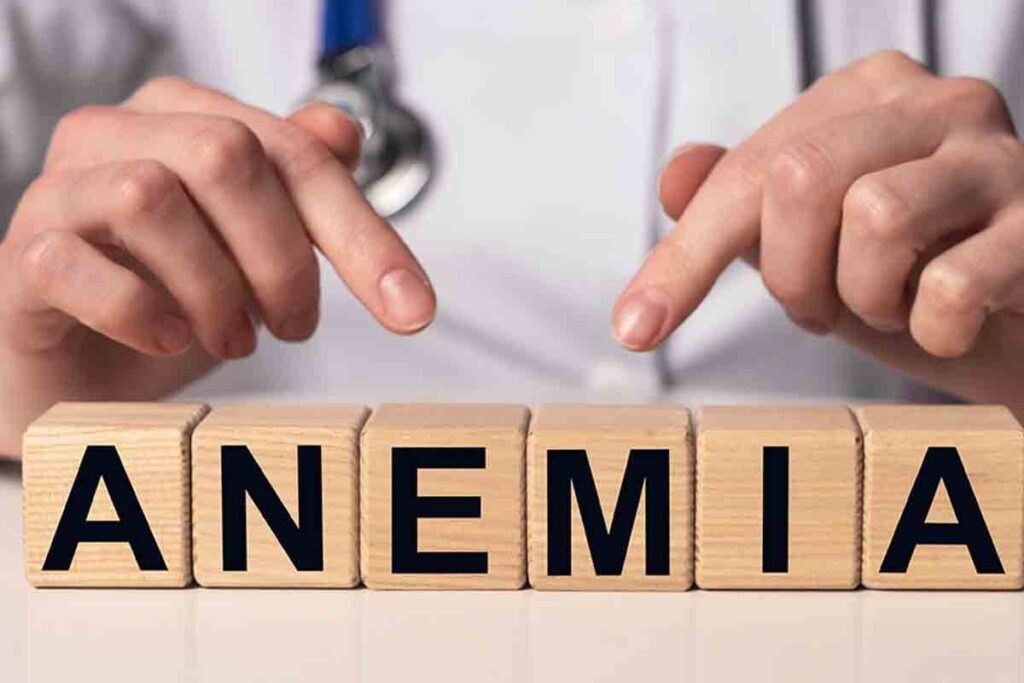
Anemia is when your body doesn’t have enough healthy red blood cells. These cells carry oxygen to all parts of your body. Without enough, your organs can’t get the oxygen they need to work right.
Many people wonder, can anemia cause death? In severe cases, it can. This lack of oxygen can cause your organs to fail, leading to serious and dangerous complications.
At Liv Hospital, we focus on treating anemia quickly to avoid these problems. We use the latest medical techniques to keep our patients safe and healthy.

Anemia is a serious condition that can harm your health if not treated. It happens when you don’t have enough red blood cells. These cells are key to carrying oxygen to your body’s parts.
Anemia is the most common blood condition in the U.S., affecting about 9.3% of the population. Women, young children, and people with long-term diseases are more likely to have anemia. In 2019, anemia caused 50 million years of healthy life lost globally, showing its big impact on health.
Anemia happens when your body lacks red blood cells or when these cells don’t carry enough oxygen. It can be caused by iron or vitamin deficiency, chronic diseases, or genetic disorders.
There are several types of anemia, each with different levels of severity. The most common is iron deficiency anemia, caused by a lack of iron. Other types include vitamin deficiency anemia, anemia of chronic disease, and sickle cell anemia. Anemia can range from mild to severe, with severe cases being life-threatening if untreated.
It’s important to know the signs and symptoms of anemia for early treatment. Common signs include fatigue, weakness, pale skin, and shortness of breath. Severe anemia can cause heart problems and poor pregnancy outcomes, among other issues.

Anemia can lead to death by changing how the body works. It happens when there are not enough red blood cells or hemoglobin. This makes it hard for the body to get oxygen to its cells and organs.
Not getting enough oxygen is a big problem with anemia. Organs like the brain, heart, and kidneys don’t work right. This can cause dizziness, confusion, and even loss of consciousness.
Severe cases of anemia, like aplastic anemia and sickle cell disease, are very dangerous. They not only reduce red blood cells but also make them less effective. Without proper treatment, these conditions can be deadly.
Severe anemia really hurts the heart and blood vessels. The heart works harder to get oxygen to the body. This can cause heart failure, arrhythmias, and angina.
Chronic anemia puts a lot of strain on the heart over time. This can make the heart change shape, increasing the risk of heart problems. It’s very important to manage anemia well to avoid these issues.
Long-term lack of oxygen from anemia affects the body’s metabolism. Cells start to use anaerobic metabolism, making lactic acid and causing metabolic acidosis. This can hurt organ function and lead to more problems.
In summary, anemia can be deadly due to oxygen lack, heart problems, and metabolic issues. Knowing how anemia works helps us see why treating it quickly and effectively is so important.
It’s important to know the global and national stats on anemia deaths. Anemia affects millions worldwide, causing a lot of sickness and death.
Anemia has a big impact on health globally. It leads to about 50 million years of lost healthy life each year. This shows how serious anemia is as a health problem.
Some areas and groups face more anemia problems. This is because of many reasons.
Key factors contributing to the global impact of anemia include:
In the U.S., anemia is a big health issue, causing deaths. About 1.6 deaths per 100,000 people are due to anemia each year. This shows we need to keep working on preventing and managing anemia.
Anemia is common in hospital patients, affecting about 50%. For older patients, it’s even higher, at 80%. This shows how important it is to diagnose and treat anemia well in hospitals.
Anemia deaths aren’t spread out evenly. Some groups face more risks because of their health and social situations. For example, people with long-term illnesses, pregnant women, and the elderly are more at risk.
Healthcare access and quality also affect anemia deaths. Those who can’t get to healthcare often suffer more because of untreated anemia.
“Addressing the disparities in anemia-related deaths requires a multifaceted approach that includes improving healthcare access, nutritional support, and managing chronic conditions effectively.”
— World Health Organization
Knowing these stats helps us tackle anemia better. We can work to lower anemia deaths worldwide.
Anemia is often linked to feeling tired. But some types can cause serious and even deadly problems. It’s important to catch these anemias early and treat them quickly.
Aplastic anemia happens when the bone marrow can’t make new blood cells. This leads to a big drop in red and white blood cells and platelets. It can be caused by toxins, some medicines, and viruses.
If not treated, aplastic anemia can be deadly. It raises the risk of serious infections and bleeding.
Sickle cell disease is a genetic disorder. It makes red blood cells break down and become misshapen. This can cause a lot of problems, like pain, infections, and damage to organs.
It can also shorten a person’s life. Patients face risks of serious issues, like acute chest syndrome and stroke.
Severe iron deficiency anemia can cause more than just tiredness. It can lead to heart issues, problems during pregnancy, and affect brain function. In the worst cases, it can cause heart failure, which is deadly.
It’s vital to treat it quickly to avoid these serious problems.
Hemolytic anemia occurs when red blood cells are destroyed too fast. It can be caused by infections, medicines, and autoimmune diseases. Severe cases can lead to heart failure and severe jaundice.
Knowing about these high-risk anemias is key. Early detection and treatment can greatly improve chances of survival and reduce the risk of fatal outcomes.
It’s vital to know the warning signs of life-threatening anemia. This knowledge helps in getting medical help quickly. We need to spot the symptoms that show a severe and possibly deadly condition.
Early signs of anemia are often subtle and missed. Common signs include extreme fatigue, weakness, and pale skin. These can be mistaken for milder issues, causing a delay in getting help.
As anemia gets worse, symptoms get more serious. Look out for shortness of breath, dizziness, and chest pain. It’s key to notice these signs and get medical help if they don’t go away or get worse.
In severe cases, anemia can cause serious problems. Signs that need urgent medical care include loss of consciousness, stroke, heart failure, and respiratory failure. If you or someone you know has these symptoms, get emergency medical help right away.
Knowing how serious anemia can be is important. It helps us take care of our health better. We stress the need to be aware of warning signs and get medical help fast.
Several key factors can increase the risk of death from anemia. Some groups are more at risk. Knowing these factors helps prevent fatal outcomes.
Delayed diagnosis and treatment are major risks. If anemia is not caught and treated early, it can cause severe problems. This is true, even more so for those at higher risk.
Underlying health issues can make anemia worse. Conditions like chronic kidney disease, cancer, and HIV/AIDS can make it hard to manage anemia. This increases the risk of death.
| Underlying Condition | Impact on Anemia | Risk Level |
| Chronic Kidney Disease | Reduces erythropoietin production, leading to anemia | High |
| Cancer | Chemotherapy can cause anemia; cancer can lead to chronic anemia | High |
| HIV/AIDS | Can lead to anemia due to disease progression or treatment side effects | High |
Age is a big factor in anemia risks. Older adults face more health issues and may not get enough nutrients. This makes them more vulnerable.
Socioeconomic status and healthcare access also matter. People from lower backgrounds may struggle to get medical help. This can lead to late diagnosis and treatment.
We need to understand these risks to help those with anemia. By addressing these factors, we can lower the risk of fatal complications.
Diagnosing anemia is key to avoiding its deadly risks. It involves a detailed process to find out how severe and why it’s happening.
Some lab values are very important for checking how bad anemia is and if it could be deadly. These include:
| Laboratory Value | Normal Range | Critical Value |
| Hemoglobin (g/dL) | 13.8-17.2 (male) | <8 |
| Hematocrit (%) | 40.7-50.3 (male) | <25 |
| Red Blood Cell Count (million cells/μL) | 4.32-5.72 (male) | <3 |
Critical laboratory values show severe anemia. It’s a sign to get medical help fast to avoid serious problems.
Healthcare providers use different tests to check how bad anemia is and its effects. These include:
If you have symptoms like:
Quick medical help is vital for severe anemia.
Preventing fatal outcomes from anemia starts with timely treatment. Anemia can lead to severe health issues if not treated. Luckily, there are effective ways to manage anemia and stop it from becoming deadly.
Dealing with severe anemia goes beyond diet and lifestyle changes. It often needs medical help,, like blood transfusions, bone marrow transplants, and medicines. We’ll look at these treatments in more detail.
When anemia is severe, quick medical action is key. Emergency treatments aim to quickly get oxygen to tissues and organs. Blood transfusions are often used, mainly for significant blood loss or severe hemolytic anemia.
For example, someone with severe aplastic anemia might need blood transfusions right away. This helps increase red blood cells and improves oxygen to vital organs. Medical research shows that timely transfusions can greatly improve outcomes in such cases.
Blood transfusions are vital in managing severe anemia by quickly boosting red blood cells. They are essential in acute blood loss, sickle cell crisis, or severe anemia due to bone marrow failure.
The transfusion process carefully matches blood types to avoid bad reactions. While lifesaving, transfusions carry risks like reactions or infections. So, they are used carefully based on medical guidelines.
Emergency treatments like blood transfusions help right away, but treating the cause is key for long-term success. This might mean treating iron deficiency, vitamin deficiency, or chronic diseases that cause anemia.
For iron-deficiency anemia, iron supplements are key. Sometimes, just changing your diet is enough. But other times, intravenous iron is needed for faster correction.
Managing anemia long-term means regular check-ups, lifestyle changes, and sometimes ongoing treatment. People with chronic anemia need a detailed care plan. This includes regular visits, diet advice, and managing underlying conditions.
Those with genetic anemia, like sickle cell disease or thalassemia, need ongoing care. This might include regular blood transfusions, medicines to prevent complications, and sometimes bone marrow transplantation.
We can lower anemia cases and reduce deadly risks by taking steps to prevent it. This includes changing our diet, getting regular health checks, and managing health issues.
Eating foods high in iron is key to avoiding iron deficiency anemia. Foods like red meat, poultry, fish, beans, lentils, and fortified cereals are good choices. Adding vitamin C foods, like citrus fruits and tomatoes, helps iron absorption.
Screening regularly is critical for catching anemia early, mainly in those at higher risk. The World Health Organization points out that pregnant women, children under five, and those with chronic diseases are at higher risk.
| High-Risk Group | Recommended Screening Frequency |
| Pregnant Women | At least once during pregnancy |
| Children Under Five | At least once a year |
| Individuals with Chronic Diseases | As advised by the healthcare provider |
Chronic diseases like kidney disease, cancer, and HIV/AIDS can lead to anemia. Effective management through medication, lifestyle changes, and regular doctor visits can prevent anemia.
By using these prevention strategies, we can greatly lower anemia-related death. It’s a team effort involving healthcare, individuals, and communities to promote health and prevent disease.
We know some groups are more at risk for anemia. They need extra care to handle their condition well.
Pregnant women need more iron because of their growing babies. Anemia in pregnancy can cause serious problems, like postpartum hemorrhage. This is a big reason for deaths in new moms. It’s important to watch their iron levels and give them supplements.
Older people often have many health issues. These can make them more likely to get anemia. Anemia can make their health problems worse, even leading to death. Comprehensive geriatric care that includes managing anemia is key to helping them.
People with chronic kidney disease (CKD) are at high risk for anemia. This is because their kidneys don’t make enough erythropoietin. Anemia can make them feel tired and lower their quality of life. It also raises their heart disease. Treating anemia in these patients means tackling their kidney disease and might include special medicines and iron.
People with genetic blood disorders like sickle cell disease and thalassemia are more likely to have anemia. They need special treatment, like blood transfusions and iron chelation, to avoid iron overload. New research and personalized medicine are helping to better manage these conditions.
Anemia is a serious condition that can lead to death if not treated. We’ve looked into how anemia can be fatal and what increases this risk. Knowing about anemia is key to avoiding deadly outcomes by getting it diagnosed and treated early.
With the right medical care, anemia can be managed and its death risk lowered. It’s important to tackle underlying health issues, manage chronic diseases, and take steps to prevent anemia. This helps reduce the risk of anemia-related deaths.
Recognizing anemia’s warning signs and symptoms is critical. This way, people can get medical help quickly. Doctors also have a big role in spotting high-risk patients and helping prevent fatal complications.
In the end, understanding anemia and its deadly risks is the first step to lowering anemia-related deaths. We need to keep teaching people about the dangers. We should also encourage them to seek medical help if symptoms get worse or don’t go away.
Yes, anemia can be deadly if not treated. It can cause oxygen deprivation and heart problems. These can lead to serious health issues and even death.
Aplastic anemia, sickle cell disease, severe iron deficiency anemia, and hemolytic anemia are dangerous. They can be fatal if not managed well.
Early signs of anemia might be missed. But serious symptoms like severe fatigue, shortness of breath, and dizziness need immediate help.
Yes, severe iron deficiency anemia can be deadly. It can cause heart problems and other serious issues if not treated.
Doctors use tests like complete blood count (CBC) to diagnose anemia. Severe anemia is a big risk for death.
To avoid fatal outcomes, treatments include emergency care, blood transfusions, and managing the cause. Long-term care is also important.
Yes, anemia can be prevented. Nutritional care, regular screenings, and managing chronic conditions are key strategies.
Pregnant women, the elderly, those with chronic kidney disease, and genetic blood disorders are at higher risk. They need extra care.
Yes, anemia can be deadly for pregnant women, especially if severe. It increases the risk of serious complications after birth.
Yes, anemia is a big concern worldwide. It affects millions and causes a lot of health problems and deaths.
Yes, low hemoglobin can be deadly if not treated. It can lead to heart issues and other serious problems.
Socioeconomic factors like healthcare access and nutrition greatly affect anemia-related deaths. This is more true in poorer areas.
Subscribe to our e-newsletter to stay informed about the latest innovations in the world of health and exclusive offers!
WhatsApp us